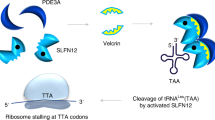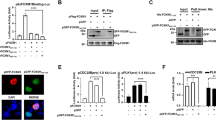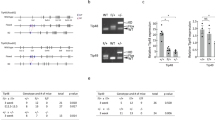Abstract
A variety of studies implicate the E2F transcription factor as a critical regulator of the mammalian cell cycle. The E2F pathway is aberrant in most, if not all, human tumor cells; therefore, therapeutic regimes that modulate E2F activity may provide an approach for reinstating growth control in situations where normal physiological control is lost. To elucidate the role of E2F in the cell cycle and assess its value as a therapeutic target, we have introduced peptides that functionally antagonize E2F DNA binding activity into mammalian cells. Introduction of these peptides into mammalian tumor cells caused the rapid onset of apoptosis, an outcome that correlates with the inactivation of physiological E2F.
This is a preview of subscription content, access via your institution
Access options
Subscribe to this journal
Receive 12 print issues and online access
$209.00 per year
only $17.42 per issue
Buy this article
- Purchase on Springer Link
- Instant access to full article PDF
Prices may be subject to local taxes which are calculated during checkout
Similar content being viewed by others
References
Weinberg, R.A. 1995. The retinoblastoma protein and cell cycle control. Cell 81: 323–330.
Nevins, J.R. 1992. E2F: a link between the Rb tumor suppressor protein and viral oncoproteins.Science 258: 424–429.
La Thangue, N.B. 1994. DRTF1/E2F:an expanding family of heterodimeric transcription factors implicated in cell-cycle control. Trends Biochem. Sci. 19: 108–114.
Lam, E.W.-F. and La Thangue, N.B. 1994. DP and E2F proteins: coordinating transcription with cell cycle progression. Curr. Op. Cell. Biol. 6: 859–866.
Johnson, D.G., Schwarz, U.K., Cress, W.D., and Nevins, J.R. 1993. Expression of transcription factor E2F1 induces quiescent cells to enter S phase. Nature 365: 349–351.
Qin, X.-Q., Livingston, D.M., Kaelin, W.G. and Adams, P.D. 1994. Deregulated transcription factor E2F-1 expression leads to S-phase entry and p53-mediated apoptosis. Proc. Natl. Acad. Sci. USA 91: 10918–10922.
Wu, X. and Levine, A.J. 1994. P53 and E2F-1 cooperate to mediate apoptosis.Proc. Natl. Acad. Sci. USA 91: 3602–3606.
ZulL, L., Van den Heuvel, S., Helin, K., Fattaey, A., Ewen, M., Livingston, D., et al. 1993. Inhibition of cell proliferation by p107, a relative of the retinoblastoma protein. Genes Dev. 7: 1111–1125.
Sherr, C.J. 1993. Mammalian G1 cyclins. Cell 73: 1059–1065.
Pines, J. 1995. CDKs and cancer. Sem. Cancer Biol. 6: 63–72.
Kato, J., Matsushime, H., Hiebert, S.W., Ewen, M.E., and Sheer, C.J. 1993. Direct binding of cyclin D to the retinoblastoma gene product (pRb) and pRb phospho-rylation by the cyclin D-dependent kinases CDK4. Genes Dev. 7: 331–342.
Sherr, C.J. and Roberts, J.M. 1995. Inhibitors of mammalian G1 cyclin-depen-dent kinases. Genes Dev. 9: 1149–1163.
Lukas, J., Parry, D., Aagaard, L., Mann, D.J., Bartkova, J., Strauss, M., et al. 1995. Retinoblastoma-protein-dependent cell-cycle inhibition by the tumor suppressor p16. Nature 375: 503–506.
Koh, J., Enders, G.H., Dynlacht, B.D. and Harlow, E. 1995. Tumor-derived p16 alleles encoding proteins defective in cell-cycle inhibition. Nature 375: 506–510.
Bandara, L.R. and La Thangue, N.B. 1991. Ela prevents the retinoblastoma gene product from complexing with a cellular transcription factor. Nature 351: 494–497.
Chellappan, S.P., Hiebert, S., Mudryj, M., Horowitz, J.M., and Nevins, J.R. 1991. The E2F transcription factor is a cellular target for the Rb protein. Cell 65: 1053–1061.
Zwicker, J. and Müller, R. 1997. Cell-cycle regulation of gene expression by transcriptional repression. Trends.Gen. 13: 3–6.
Zwicker, J., Lucibello, F.C., Wolfraim, L.A., Gross, C., Truss, M., Engeland, K., Müller, R. 1995. Cell-cycle regulation of the cyclin A, cdc25C and cdc2 genes is based on a common mechanism of transcriptional repression. EMBO J. 14: 4514–4522.
Flemington, E.K., Speck, S.H. and Kaelin, W.G. 1993. E2F-1 mediated transactivation is inhibited by complex formation with the retinoblastoma susceptibility gene product.Proc. Natl. Acad. Sci. USA 90: 6914–6918.
Helin, K., Harlow, E., Fattaey, A.R. 1993. Inhibition of E2F-1 trans-activation by direct binding of the retinoblastoma protein. Mol. Cell. Biol. 13: 6501–6508.
Girling, R., Partridge, J.F., Bandara, L.R., Burden, N., Totty, N.F., Hsuan, J.J. and La Thangue, N.B. 1993. A new component of the transcription factor DRTF1/E2F. Nature 362: 83–87.
Bandara, L.R., Buck, V.M., Zamanian, M., Johnston, L.H., and La Thangue, N.B. 1993. Functional synergy between DP-1 and E2F-1 in the cell cycle-regulating transcription factor DRTF1/E2F. EMBO J. 13: 4317–4324.
Bandara, L.R., Lam, E.W.-F., Sorensen, T.S., Zamanian, M., Girling, R., and La Thangue, N.B. 1994. DP-1: a cell cycle-regulated and phosphorylated component of transcription factor DRTF1/E2F which is functionally important for recognition by pRb and the adenovirus E4 orf 6/7 protein. EMBO J. 13: 3104–3114.
Johnson, D.G., Cress, W.D. Jakoi L., and Nevins, J.R. 1994. Oncogenic capacity of the E2F1 gene. Proc. Natl. Acad. Sci. USA 91: 12823–12827.
Singh, R., Wong, S.H., and Hong, W. 1994. Overexpression of E2F-1 in rat embryo fibroblasts leads to neoplastic transformation. EMBO J. 14: 3329–3338.
Jooss, K., Lam, E.W.-f., Bybee, A., Girling, R., Müller, R., and La Thangue, N.B. 1995. Proto-oncogenic properties of the DP family of proteins. Oncogene 10: 1529–1536.
Xu, F.H., Alphey, L., Bandara, L.R., Lam, E.W.-F., Glover, D., and La Thangue, N.B. 1995. Functional conservation of the cell cycle-regulating transcription factor DRTF1/E2F and its pathway of control in Drosophila melanogaster. J. Cell Science 108: 2945–2954.
Derossi, D., Joliot, A.H., Chassaing, G., and Prochiantz, A. 1994. The third helix of the antennapedia homeodomain translocates through biological membrances. J. Biol. Chem. 269: 10444–10450.
Fahraeus, R., Paramio, J.M., Ball, K.L., Lain, S., and Lane, D.P. 1996. Inhibition of pRb phosphorylation and cell cycle progression by a 20-residue peptide derived from P16CDKN2/1NMA. Current Biology 6: 84–91.
Beijersbergen, R.L., Kerkhoven, R.M., Zhu, L., Carlee, L., Voorhoeve, P.M., and Bernards, R. 1994. E2F-4, a new member of the E2F gene family, has oncogenic activity and associates with p 107 in vivo. Genes Dev. 8: 2680–2690.
Pan, H. and Griggs, A.E. 1994. Altered cell cycle regulation in the lens of HPV-16 E6 or E7 transgenic mice: implication for tumor suppressor gene function in development. Genes Dev. 8: 1285–1299.
Clarke, A.R., Mazndag, E.R., Van Roon, M. Van der Lugt, N.M.T., Van der Valk, M., Hooper, M.J., et al. 1992. Requirement for a functional Rb-1 gene in murine development. Nature 359: 328–330.
Jacks, T., Fazeli, A., Schmitt, E.M., Bronson, R.T., Goodell, M.A., and Weinberg, R.A. 1992. Effects of an Rb mutation in the mouse. Nature 359: 295–300.
Morgenbesser, S.D., Williams, B.O., Jacks, T., and DePinho, R.A. 1994. P53-dependent apoptosis produced by Rb-deficiency in the developing mouse lens. Nature 371: 72–74.
Field, S.J., Tsai, F.-Y., Kuo, F., Zubiaga, A.M., Kaelin, W.G., Livingston, D.M., et al. 1996. E2F-1 functions in mice to promote apoptosis and suppress proliferation cell. Cell 85: 549–561.
Yamasaki, L., Jacks, T., Bronson, R., Goillot, E., Harlow, E., and Dyson, N. 1996. Tumor induction and tissue a trophy in mice lacking E2F-1. Cell 85: 537–5478
Weintraub, S.J., Cho, K.N.B., Luo, R.X., Zhang, S.H., He, S. and Dean, D.C. 1995. Mechanism of active transcriptional repression by the retinoblastoma protein. Nature 358: 259–261.
Author information
Authors and Affiliations
Rights and permissions
About this article
Cite this article
Bandara, L., Girling, R. & Thangue, N. Apoptosis induced in mammalian cells by small peptides that functionally antagonize the Rb-regulated E2F transcription factor. Nat Biotechnol 15, 896–901 (1997). https://doi.org/10.1038/nbt0997-896
Received:
Accepted:
Issue Date:
DOI: https://doi.org/10.1038/nbt0997-896
This article is cited by
-
The broken cycle: E2F dysfunction in cancer
Nature Reviews Cancer (2019)
-
Determining therapeutic susceptibility in multiple myeloma by single-cell mass accumulation
Nature Communications (2017)
-
Established and new mouse models reveal E2f1 and Cdk2 dependency of retinoblastoma, and expose effective strategies to block tumor initiation
Oncogene (2012)
-
E2F-1 as an anticancer drug target
Oncology Reviews (2009)
-
DNA-binding independent cell death from a minimal proapoptotic region of E2F-1
Oncogene (2006)



